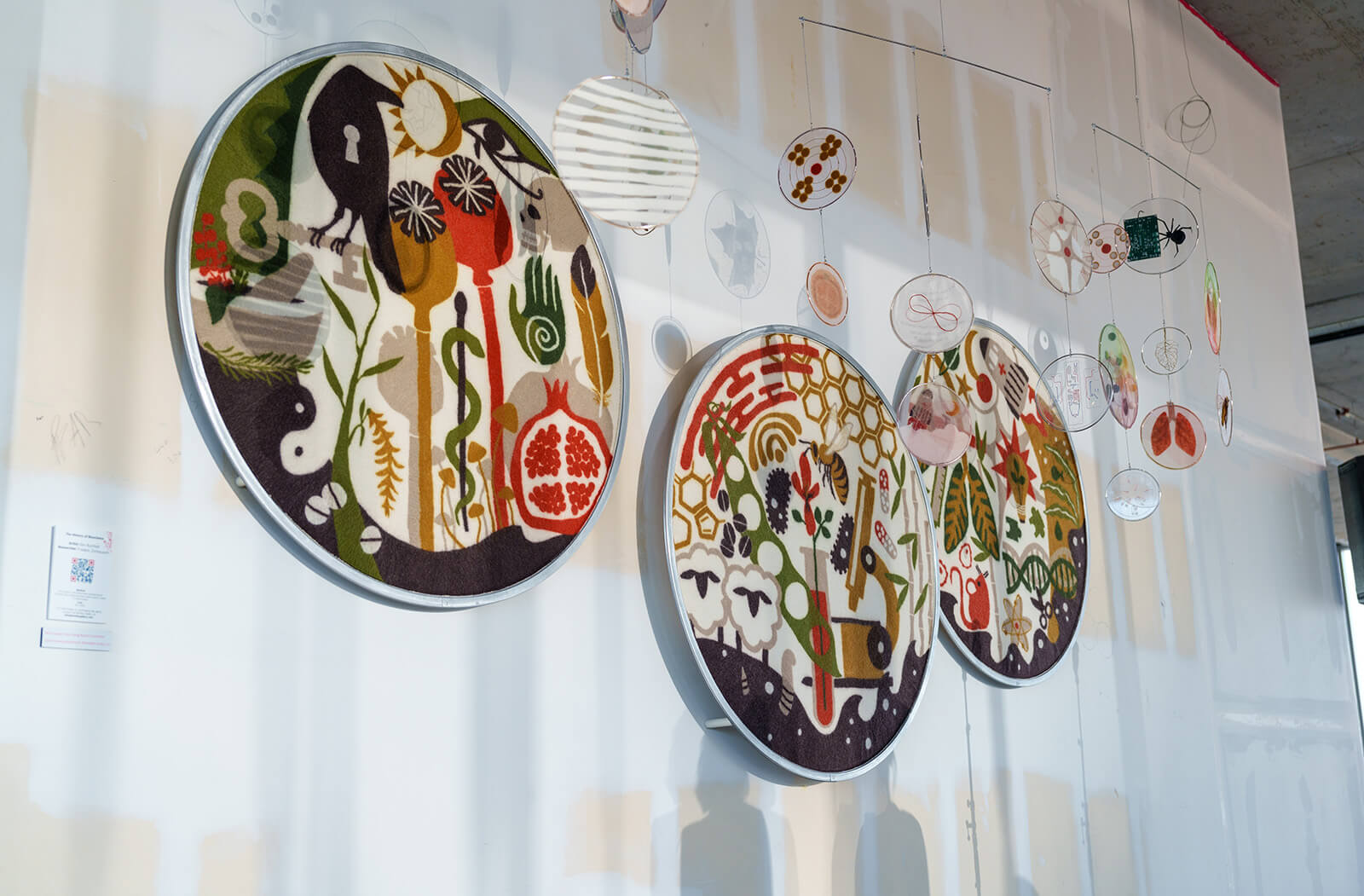
Artists and Researchers Unveil Translational Art that Showcases Medical Research

So much of scientific research is visual, but it is often difficult to convey the meaning of the images to a broad audience. To help conceptualize scientific discovery, teams of local artists and researchers created original pieces, which premiered at the second Artist + Researcher Exhibition.
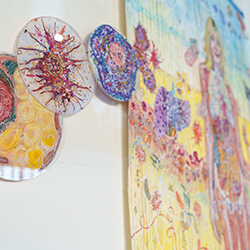
“The idea behind the project is to see what happens when research is presented through an artistic lens,” Dr. Standley said. “Art’s visual appeal can serve as a bridge to generate interest in science and to inspire people to want to know more. Through this program, the researchers see their work displayed in a unique way.”
After the first cohort — which featured nine pairings — proved to be a success, organizing a second group was a foregone conclusion.
The second cohort features 10 researchers from Arizona State University (ASU), Northern Arizona University (NAU), the College of Medicine – Phoenix, as well as the Translational Genomics Research Institute (TGen) and a local startup, ElectraTect. They worked side-by-side with artists from the greater Phoenix Metro area over the course of nine months.
Partnering in the lab, classroom and studio, they developed vibrant works that would communicate each researchers’ area of expertise. A few of the artists and researchers shared their perspectives on the project and how their exhibits reflect their work.
Emotional Contagion (EC) Corps
Barret Michalec, PhD, director of the Center for Advancing Interprofessional Practice, Education and Research at ASU, is an award-winning sociologist, whose focus is developing evidence-supported practices to cultivate humility, empathy and well-being among health care professionals and health profession students.
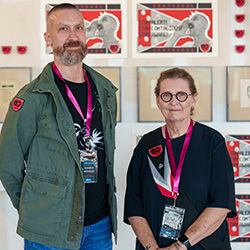
The essential message: In an age where machines consume much of our time, it is crucial to be willing to connect with those around us, especially for physicians.
“When we see others with sadness, or anger or happiness, we feel a level of that emotion and come to mimic their emotional state,” Dr. Michalec said. They wanted their project to serve as a reminder for health care providers to appreciate the feelings patients exhibit to “engage more authentically” with them.
“I was able to actually take one of Barret’s classes … and three things really emerged from his research and our discussion,” Morton said.
First, Dr. Michalec sees his work as a form of protest within the health care system. Second, a physician must learn to seize the limited moments available to them to recognize a patient’s emotional state. With that recognition, comes the third, and most valuable lesson, “To have empathy and to get inside someone else’s emotions,” she said.
Weaving Time and Gliding Canyons
Melissa Herbst-Kralovetz, PhD, associate professor in the Departments of Basic Medical Sciences (BMS) and Obstetrics and Gynecology, as well as director of the Herbst- Kralovetz Research Lab, worked alongside Charmagne Vasquez.
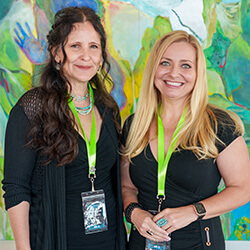
“The more we discussed the cellular structure of lactobacilli and its protective bacterial journey in a woman’s body, the more I was convinced that I could create a visual landscape.” Vasquez wrote in her description of the piece. “We both knew that turquoise is of great significance in many Arizona indigenous cultures, and we were excited for it to also align with the positive nature of lactobacilli. I thought there may be a way to integrate several messages through the creation of characters and creatures.”
Vasquez even embedded three-dimensional media — raw turquoise stone and hand-rolled beads, including opals, crafted by her father, a master jeweler — into the painting to further that symbolism.
“I just think it is so great to have been on this journey with her and to have this partnership with her,” Dr. Herbst-Kralovetz said.
Through her art, Vasquez examines humankind’s place within biological symbiosis. And with Mexican, Chicano and Apache heritage, she noted how Dr. Herbst- Kralovetz’s emphasis on improving the health of underserved populations made their pairing a perfect fit.
Future Health Outcomes
The work of Chad Stecher, PhD, assistant professor, College of Health Solutions, ASU, involves wearable devices and how they measure behavior, as well as support the maintenance of a healthy lifestyle. As technology rapidly improves, the health outcomes and results he witnesses today will only vaguely resemble those of the future.
“We started thinking about what the future of wearables might look like and thought about where on the body would that be, but also, how do those need to be personalized and maybe they become creative sources of expression,” Dr. Stecher explained.
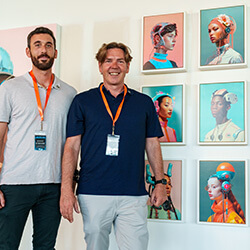
Each of the portraits offered a glimpse into how much more accessible the customization of wearables will become. The team used artificial intelligence (AI) to generate a unique device design for each portrait. Attendees could experience the futuristic wearable designs by scanning a QR code at the exhibit and using their phone as a viewer.
Angel explained the process of creating the portraits, “Each one represents hundreds of iterations. And we decided on this one as the best reflection of the research.” He also stressed that though the possibilities AI presented were exciting, they were not without error. Which is why he, “Included the iterative process to demonstrate the limitations.”
With interest in participating in the program expanding, Dr. Standley plans for this to be an annual exhibit. “The Phoenix Bioscience Core’s (PBC) Arts Committee is wholly supported by contributions from our partners and the greater Phoenix community,” she said. And she wanted to thank the primary sponsors of the exhibition — the City of Phoenix Office of Arts and Culture, the Bentley Gallery, the PBC and the College of Medicine – Phoenix — for their continued support.
2023 Cohort
- Now Go Be Normal – Suzanne Whitaker and Amy Armstrong-Heimsoth, OTD, OTR/L, department chair and associate clinical professor, Department of Occupational Therapy, NAU.
- The Space Between Two – Zach Valent and Derek Cridebring, PhD, director, Molecular Medicine Division, TGen.
- Portrait of Johanna – Monica Aissa and Johanna DiStefano, PhD, professor and head of the Diabetes and Fibrotic Disease Unit, TGen.
- Use Cases – Jen Urso and Evan Darzi, PhD, CEO, ElectraTect.
- Weaving Time and Gliding Canyons – Charmagne Vasquez and Dr. Herbst-Kralovetz.
- EC Corps – Ann Morton and Dr. Michalec.
- The Mirror – Nicole L. Olson and Vinodh Narayanan, MD, medical director, Center for Rare Childhood Disorders, TGen.
- Future Health Outcomes – James Angel and Dr. Stecher.
- Message in a Bottle – Mary Lucking and Anne Titelbaum, PhD, associate professor, BMS, College of Medicine – Phoenix.
- The History of Bioscience – Kim Buchheit and Frederic Zenhausern, PhD, MBA, Endowed Chair Professor, director, Center for Applied NanoBioscience and Medicine, College of Medicine – Phoenix.
The official grand opening of the exhibition was held Saturday, August 19, at the Bentley Gallery in Downtown Phoenix. An in-depth conversation with the artists and researchers from the two cohorts will be hosted by Dr. Standley when the exhibition moves to the PBC campus Thursday, September 14.
About the College
Founded in 2007, the University of Arizona College of Medicine – Phoenix inspires and trains exemplary physicians, scientists and leaders to advance its core missions in education, research, clinical care and service to communities across Arizona. The college’s strength lies in our collaborations and partnerships with clinical affiliates, community organizations and industry sponsors. With our primary affiliate, Banner Health, we are recognized as the premier academic medical center in Phoenix. As an anchor institution of the Phoenix Bioscience Core, the college is home to signature research programs in neurosciences, cardiopulmonary diseases, immunology, informatics and metabolism. These focus areas uniquely position us to drive biomedical research and bolster economic development in the region.
As an urban institution with strong roots in rural and tribal health, the college has graduated more than 1,000 physicians and matriculates 130 students each year. Greater than 60% of matriculating students are from Arizona and many continue training at our GME sponsored residency programs, ultimately pursuing local academic and community-based opportunities. While our traditional four-year program continues to thrive, we will launch our recently approved accelerated three-year medical student curriculum with exclusive focus on primary care. This program is designed to further enhance workforce retention needs across Arizona.
The college has embarked on our strategic plan for 2025 to 2030. Learn more.